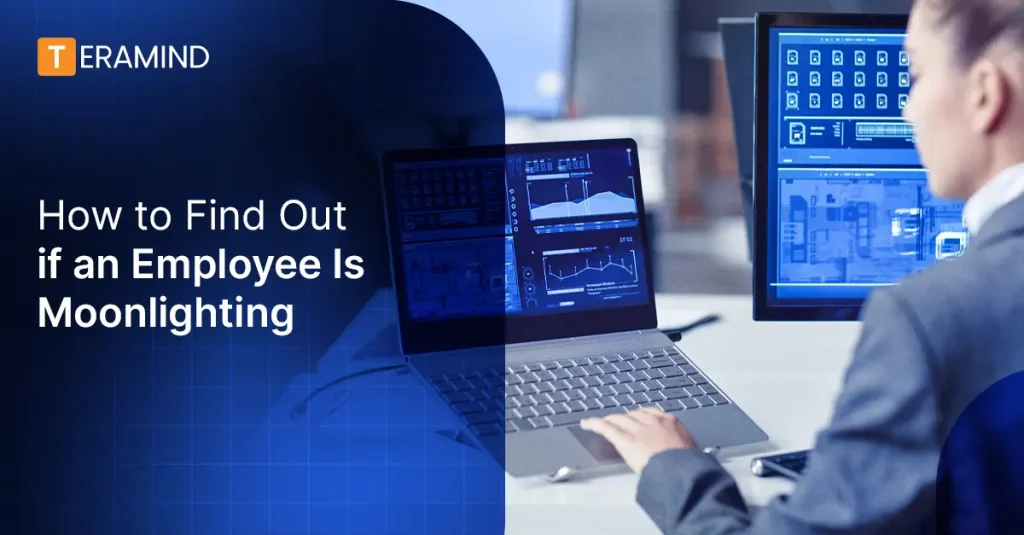Did you know that around 45% of working Americans have a side hustle (a secondary job) that they work alongside their current job? With costs rising and many feeling underpaid, it’s become widespread for people to pursue dual employment. This practice of working two jobs concurrently is called “moonlighting.”
While moonlighting can be a way for employees to earn extra income, it does pose potential risks for employers. Staff distracted by other work often see productivity and performance suffer at their primary job, with possible conflicts of interest arising, such as working for a competitor or misusing confidential company data and resources.
As an employer, it’s essential to know if your employees are moonlighting so you can address any issues proactively.
What is Employee Moonlighting?
Employee moonlighting means working a second, often part-time, job in addition to one’s regular, primary job. It could involve freelancing, running a side business, or working part-time hours at another company in addition to working for their current employer.
How To Find Out if Employees Are Moonlighting
There are several ways companies can try and identify moonlighting employees. Remember that when tracking employee behavior, both in and out of work hours and locations, businesses must be very strict about what they monitor and how they store that data. Otherwise, they will breach employee confidentially and data protection laws, which could lead to severe legal repercussions.
Keeping this in mind, some of the best ways to determine if employees are moonlighting include:
Use Employee Monitoring Software
Many employers use monitoring tools like Teramind’s Employee Monitoring software to track employee computer and internet activity during work hours. This software can log things like:
- Websites visited
- Apps and programs used
- Time spent on work vs. non-work tasks
- Email and messaging activity
If the logs show an employee spending significant time on tasks seemingly unrelated to their job duties, it could indicate they are working a side gig during paid hours.
Track User Activity
In addition to computer monitoring, employers may also track employee and user activity through other means:
- Security camera footage
- Badge/key entry logs
- Location services on company devices
- Calls/messages on work phones
Inconsistencies like an employee being away from their desk for long periods, unusual entry/exit times, or activity on work resources from strange locations can potentially expose moonlighting.
Measure Changes in Productivity
Decreased employee performance and productivity can be a red flag that an employee’s focus is divided due to a second job. Supervisors should document any:
- Missed deadlines or sloppy work
- Decreased output compared to their usual
- Signs of burnout or fatigue
- Failing to respond promptly
Consistent decline in work performance may stem from the employee being overworked or distracted by their side job.
Monitor Network Activity
IT teams can inspect network usage logs to identify any unusual activity, such as:
- Large data transfers
- Unauthorized access attempts
- Strange peripheral connections
- Remote computer access from unknown IPs
Suspicious network behavior might indicate employees accessing company systems to assist clients or share data for their second gig.
Any surveillance and data collected with these methods must be transparently explained to employees in employment agreements. Protecting the work your employees do for your organization is important, but it’s also essential that your employees feel they work in a secure and safe environment.
Why Moonlighting Employees Are a Risk to Your Organization
It can be difficult for employees in the modern workforce. 30% of all employees with a second job say they take it on because they need the extra money to cover basic costs.
Nonetheless, for you as the primary employer, employee moonlighting can create conflicts of interest and serious risks. These include:
Potential Data Leaks
Distracted or resentful employees may be more careless about protecting sensitive company information. Data loss prevention is the last thing on their minds. Customer records, financial data, business plans, and other confidential information are at risk of exposure or theft if the employee uses them for outside work.
Security Issues with Company-owned Devices
When staff install unauthorized apps and browser extensions or visit unvetted websites on company laptops and devices for moonlighting, it increases vulnerability to malware and cyber threats. Sensitive data can leak, and the company network may become compromised, leading to potentially crippling data breaches.
Conflicts of Interest
If dual employment and employee moonlighting occur in a related industry or with one of your competitors, an employee could easily misuse proprietary company knowledge, intellectual property, or business strategies to benefit that outside party. This would violate their professional and legal obligations to you, their primary employer.
Decreased Productivity
As mentioned above, whether putting in long hours across multiple jobs or constantly distracted by side gig demands, moonlighting employees inevitably suffer burnout that impacts their productivity and effectiveness in their primary role.
Fatigue, missed deadlines, and sloppy work hurt the entire team’s morale and output. You’re not getting the total value and effort you’re paying for from that employee.
Working for a Competitor
In worst-case scenarios, an employee may blatantly take a second job working directly for one of your competitors. This unethical situation creates apparent conflicts of interest as they now have access to two organizations’ most sensitive data, business strategies, client information, and more.
There’s a considerable risk of proprietary knowledge, trade secrets, and confidential data being misused or exposed to your detriment. How can you possibly trust that employee?
Divulging Corporate Secrets
Even if not working for a direct competitor, employees moonlighting as consultants or advisors may be tempted or prone to “talking shop” and carelessly discussing insider information that should remain confidential.
Inadvertently divulging corporate secrets, operations details, client data, or other protected knowledge while consulting could quickly undermine your competitive edge and relationship with partners and customers.
Business Processes Become Less Optimized
If employees consistently arrive late, leave early, are distracted, and turn in sloppy work, it causes business processes and workflows to break down. Projects get delayed, and overall output suffers.
How To Handle Employee Moonlighting
If you suspect or discover employees working a second job, there are some best practices to follow.
It can, and most likely will be, an uncomfortable conversation if you catch an employee moonlighting, so a proactive approach is always best.
With this in mind, we suggest you handle employee moonlighting like this:
Create A Moonlighting Policy
Establish clear company guidelines around secondary employment in your employment contract with all employees. The policy should address:
- Getting approval beforehand from human resources
- Which types of second jobs are/aren’t permitted
- Avoiding conflicts of interest
- Not working on company time/resources
- Prioritizing primary job responsibilities
Communicate these rules and consequences for violations so there’s no confusion from the beginning of your working relationship with all employees at your organization, small business, startup, or company. Employee handbooks are a great place to store this policy.
Take Disciplinary Action for Serious Insider Threats
If an employee is found to be leaking data, working for a competitor, or otherwise severely misusing their position, that’s grounds for termination. Their actions put the company at significant risk of financial and reputational damage.
Notify employees that such an infraction will likely be permanent on their employment history. Future background verification and checks by potential employers will highlight such behavior, so it’s best they follow any moonlighting policies to which they agree.
For less severe infractions, issue warnings and take disciplinary action per company policy. Emphasize that changes in behavior are required for continued employment.
Track Employees with Monitoring Software
Implement employee monitoring tools (computer tracking, internet logs, etc) to identify policy violations and address issues before significant data breaches or security incidents occur. This provides a legal way to see red flags and catch problems early.
Offer Competitive Salaries
Employees often take on side jobs or remote work because their regular paycheck isn’t enough to make ends meet, and they need additional income. Ensuring competitive market salaries and benefit packages gives staff less incentive to seek secondary employment that could undermine their work performance. More money often leads to higher job satisfaction.
This also goes a long way towards cultivating an appreciated and respected workforce, driving employee productivity and morale.
FAQs
What is unethical moonlighting?
Unethical moonlighting is when an employee engages in secondary employment without proper disclosure or approval, creating conflicts of interest and potentially jeopardizing their primary job responsibilities. It can involve working for competitors, using company resources for personal gain, or leaking sensitive information.
How do I find out if an employee is working two jobs?
To determine if an employee works two jobs, you can look for signs such as decreased productivity, frequent absences, or suspicious behavior. Additionally, implementing monitoring software and conducting discreet inquiries can help uncover whether an employee is moonlighting.
How do you identify moonlighting?
To identify moonlighting, look for signs of decreased productivity, frequent absences, or suspicious behavior. Implementing monitoring software and conducting discreet inquiries can also help uncover whether an employee is working a second job.
How do I find out if an employee is working for another job?
To determine whether an employee is working for another job, look for signs like decreased productivity, frequent absences, or suspicious behavior. Implementing monitoring software and conducting discreet inquiries can also help uncover whether an employee is moonlighting.
Wrapping Up
Moonlighting continues to increase as economic pressures mount. While getting a second income can help employees make ends meet, it also poses risks if that second job compromises their commitment and performance in their primary role.
As an employer, it’s critical to establish clear moonlighting policies and leverage monitoring tools to identify potential violations or insider threats. However, this needs to be balanced with respecting reasonable privacy boundaries for staff. An open dialogue and competitive compensation packages are recommended approaches to making staff feel cared for, which will help them give you their best.
Proactive companies managing moonlighting ethically and transparently are better positioned to protect sensitive data, maintain productivity, and nurture a loyal, focused workforce.
With this in mind, any company looking for employee monitoring solutions to ethically and effectively detect policy violations or insider threats needs to see what Teramind has to offer. Teramind’s platform provides comprehensive user activity monitoring, video recording, file tracking, and more to help identify moonlighting or improper data access before issues arise.


